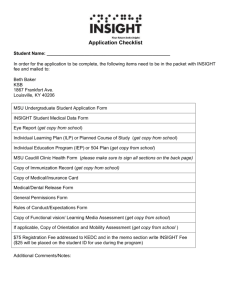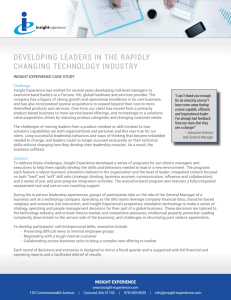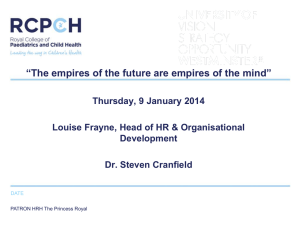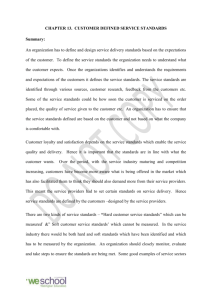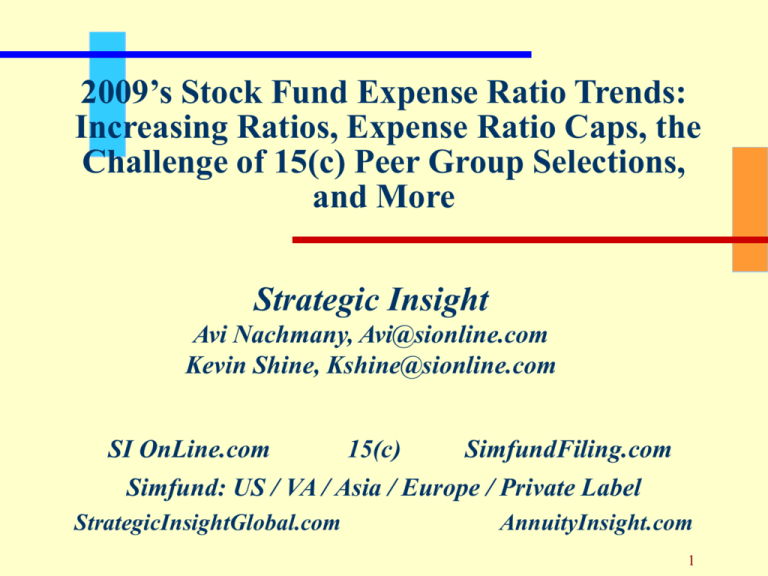
2009’s Stock Fund Expense Ratio Trends:
Increasing Ratios, Expense Ratio Caps, the
Challenge of 15(c) Peer Group Selections,
and More
Strategic Insight
Avi Nachmany, Avi@sionline.com
Kevin Shine, Kshine@sionline.com
SI OnLine.com
15(c)
SimfundFiling.com
Simfund: US / VA / Asia / Europe / Private Label
StrategicInsightGlobal.com
AnnuityInsight.com
1
Today’s Topics
A few observations on the industry, beyond
fees
Stock funds’ rising expense ratios: notable,
but having only a minimal impact on the
average shareholder account
Expense cap challenges: managers, trustees
15(c) in ’09: rely only on ’08 fiscal year
data, or supplement with estimates for ’09?
How SI can assist on fee-related research,
board guidance, and more
2
Strategic Insight
Industry Overall Sales of Equity and Bond
Funds Still Nearly $150B Monthly
Sales, Flows, and Redemptions
1999 - January 2009
16%
14%
New Sales
12%
10%
8%
Net New Flows
6%
4%
Redemptions as % Assets
2%
0%
1999
2000
2001
2002
2003
2004
2005
2006
2007
$B
300
270
240
210
180
150
120
90
60
30
0
-30
-60
-90
-120
-150
2008
Source: Strategic Insight Simfund / ICI Trends
3
Strategic Insight
Because of Retirement Funding Goals, Even
During Bear Markets, a Majority of Fund Sales are
of Equity Funds (Automatic Investments, PPA, etc.)
Share of Long-Term New Sales by Fund Type
1999 - January 2009
% of Long-Term
% of Long-Term
New Sales
New Sales
100
100
90
90
Equity/Hybrid
80
80
70
70
60
60
50
50
40
40
Taxable Bond
30
30
20
20
10
0
1999
10
Municipal Bond
0
2000
2001
2002
2003
2004
2005
2006
2007
2008
Source: Strategic Insight Simfund / ICI Trends
4
Strategic Insight
Recent Inflows Have Gone to Stock Funds with the
Highest Trailing Return / Risk Relative Ratings,
Even When Such Funds Show Large Absolute Losses
Highest Inflows Equity Funds 1/09 vs. the Fund's Trailing 5 Yr Risk / Return Profile
Actively Managed Funds, Bubble Size Measures 1/09 Inflows
Top-Left: Above Average Return, Below Average Risk
Each Fund's Rated w/in Its Lipper Classification: 5 Years Ending 1/09
Lower < 5 YR RELATIVE RETURN > Higher
100%
80%
60%
40%
20%
0%
100%
80%
60%
40%
20%
0%
Lower < 5 YR DOWNSIDE RISK > Higher
5
Copyright © 1994-2009 All rights reserved. All rights reserved. Strategic Insight (SI) and the following where applicable: Investment Company Institute (IC), Lipper Inc. (LI), Morningstar Inc. (MS), and Form N-SAR filed with the SEC (NS).
The data, analyses, information, and opinions contained herein: (a) include confidential and proprietary information of the aforementioned companies, (b) only limited, ad hoc, non-systematic redistribution is permitted, (c) are provided solely for
informational purposes, and (d) are not warranted or represented to be correct, accurate, or timely. Past performance is no guarantee of future results. The aforementioned companies are not affiliated with each other.
Strategic Insight
Fee Trends in 2009: The Context
Assets of many equity funds today are half of what
they were during the fund’s latest fiscal year.
Similarly, the average stock fund shareholder
account is down by half
Falling assets and shrinking account sizes trigger fee
ratio increases. In March 2009, expense ratios for
most stock funds are much higher than the levels
reported for them during the funds’ latest fiscal year
Increase in many stock fund expense ratios: ~ 15 b.p.
Increase in cost to investors with an average account
balance ($8,000-9,000): ~ $1 monthly
6
Strategic Insight
SI’s Increasing Focus, Assistance, Data
for Fee-Related Research
2009, 2010: Attention to fee rises for managers, trustees,
fiduciaries, advisors, gatekeepers, investors, regulators… Expect
more from SI on fee research, board-related issues
Shortly, a report on this discussion today will be published on
sionline.com; register for access to our site, share the study with
trustees if appropriate…
Trustees increasingly ask for access to SI research: not just on
board-related topics, but for general perspective, trends; reach out
to us to accommodate your trustees’ interest in such research
Simfund: complete, timely fee data (open-end funds, VA funds,
ETFs, closed-end funds, sub-advisory, non-management fees…)
SimfundFiling.com: daily tracking of fund changes filed with the
SEC, smart “Google” on EDGAR, weekly synopsis, help-ondemand for specific research
25 analysts, researchers, on-call: mutual funds, VA funds, and
globally
7
Strategic Insight
SEC’s Andrew Donohue's Speech
to Fund Directors, 1/13/09
(An excerpt related to Advisory Contract Renewal…)
... this year the 15(c) process will be even more critically important.
…fund directors will likely want to consider carefully additional
information or issues that may not have been present in previous
reviews. For example, for a fund with an expense cap that has
experienced an increase in its expense ratio due to a decline in asset
values or redemptions, is it appropriate to modify or eliminate the
expense cap? What standard will the board employ to determine any
such modification? Similarly, many funds use funds in a "peer group"
as a benchmark to analyze fees charged and expense ratios incurred.
Boards should be mindful in evaluating funds within a peer group that
the funds that historically may have comprised this peer group may no
longer be a member of that group or have comparable assets under
management. The challenges you face in evaluating certain data
regarding peer funds, especially historical expense ratio and other cost
data, are not insignificant. As such, in the presence of extreme
conditions, directors should be sensitive to the limitations of
comparable data. While this sensitivity is always important, it will be
particularly essential in the coming year.
Read full speech on
http://www.sec.gov/news/speech/2009/spch011309ajd.htm
8
Strategic Insight
The “Mutual” in Mutual Funds:
A Bear Market Reminder
Every mutual fund serving individual investors has
many small accounts, and a much smaller number of
large accounts.
Costs to run such funds are proportionately
allocated based on assets: inherent in the “mutual”
fund structure is subsidization of small accounts due
to the “mutualization” of fees (management and
non-management fees)
One reason for fee ratio increases: today, each
equity fund has many more small accounts and
fewer “very large” accounts
9
Strategic Insight
Distribution of Fund Account Sizes vs. Assets: Pattern at
One Manager is Typical for Many Managers Today
70%
% of the Fund Company's Assets
60%
% of the Fund Company's Accounts
50%
40%
30%
20%
10%
0%
<5K
5-10K
10-15K
15-20K
20-25K
>25K
Account Size Range in '000 Dollars
Source: Strategic Insight Research
10
Strategic Insight
Large Cap Equity: Transfer Agent Fee Ratios of Funds
with Many Small Accounts are Higher than for Funds
with a Larger Average Account Size
Large Cap Equity Funds, Actively Managed
Average Account Size
$4,000-6,000
$7,000-9,000
$9,000-11,000
$14,000-16,000
$18,000-22,000
23,000-27,000
28,000-32,000
35,000-45,000
Median TA
Fee Ratio %
0.292
0.218
0.198
0.162
0.162
0.118
0.109
0.090
Source: Strategic Insight Simfund MF; Excl. funds under $50 million during latest fiscal year
11
Strategic Insight
Small Cap Equity: Transfer Agent Fee Ratios of Funds
with Many Small Accounts are Much Higher than for
Funds with a Larger Average Account Size (cont’d)
Small Cap Equity Funds, Actively Managed
Average Account Size
$1,000-3,000
$4,000-6,000
$7,000-9,000
$9,000-11,000
$14,000-16,000
$18,000-22,000
23,000-27,000
28,000-32,000
35,000-45,000
Median TA
Fee Ratio %
0.371
0.273
0.25
0.185
0.143
0.159
0.136
0.145
0.122
Source: Strategic Insight Simfund MF; Excl. funds under $50 million during latest fiscal year
12
Strategic Insight
Collapse of Average Account Size, And
TNAs, Triggered a Fee Ratio Spike
With stock funds’ average retail account size cut by about
half (from $16,000 to less than $10,000; the median account
size is much lower today, at maybe $5,000), TA fee ratios
spiked for many funds by over 10 basis points
Asset declines also result in small increases in other “nonmanagement” fee ratios (with increases bigger for tiny
funds), as well as in ratios for management fees among funds
with “breakpoints” in place
In total, “current” expense ratios among many equity
funds are 10, 15, or 20 basis points higher than what they
averaged in 2008 (during the fund’s latest Fiscal year)
For the investor holding today’s average equity account
balance (of maybe $8,000-9,000), this expense ratio
increase translates to $12 in additional fees each year, or
about $1 monthly
13
Strategic Insight
Funds with Expense Caps:
Cost of Fee Reimbursement High
A widespread issue: caps on Total Expense Ratio, TA
fee ratio, Unified Fee Ratios, TER “at or under peer
median”, TER “< 70% of peers”, etc
2009’s collapsed advisory fee revenues and other
cost dynamics result in unprecedented profitability
pressures on investment companies
Expense caps add to such pressures; an extra 15 b.p.
reimbursement, esp. for a large fund, is meaningful
(Beyond stock funds: need to maintain a positive
yield forces money market mutual funds into fee
waivers; certain bond funds may also be driven by
the same influences to implement such waivers)
14
Strategic Insight
Expense Caps Deliberations, Peer Group
Comparisons: My Fund’s TER Today, Peer
Funds’ (Lower) TERs from 2008
A fixed % expense cap: my fund’s March 2009
(higher) TER vs. peer funds’ (lower) TER from Fiscal
2008?
A relative TER cap (keep at “median” of peer
funds): my Fund’s TER today vs. peer funds’ last year’s
(lower) median? Or today’s (higher) median?
Either way: how to determine a peer group
analytically appropriate for both management and
trustees, and how to estimate hypothetical current
TERs for peer funds
(Back to Mr. Donohue: “What standard will the board
employ to determine any such [cap] modification?”)
15
Strategic Insight
Funds with Expense Caps: Cont’d
Much reduced profitability, coupled with fee
reimbursements, are concerns for virtually every
advisor, fund’s trustees
These unprecedented challenges are here to stay
Early responses, by some managers and trustees:
remove or relax expense caps; more to come (SI can
share such data with you)
Some may consider recapture arrangement (not simple;
note section 8.05 of the AICPA’s Investment Company
Accounting and Audit Guide, consult with your auditor)
SI assistance: monitoring expense cap changes daily,
peer group benchmarking, etc.
More in our soon-to-be-published study
16
Strategic Insight
Peer Group for 2009 15(c) Review:
Not Easy This Time
Funds are typically benchmarked vs.
similarly invested funds with comparable
assets under management “on average”
during the funds’ latest fiscal year
But March 2009 asset levels of many equity
funds are roughly half of what they averaged
during the fund’s latest fiscal year, and their
current fees are higher
15(c) in 2009: just replicate the commonly
used methodology of the past, or go beyond?
17
Strategic Insight
Peer Group for 2009 15(c) Review:
Not Easy This Time (Cont’d)
Should you supplement ’09 15(c) (based on fiscal 2008 fee
data for the fund and its peers) with a report on fund’s
current estimated fee ratios vs. peer group “hypothetical”
current fees?
If so, should it be part of the 15(c) process or a separate
analysis?
How to adjust the methodology for peer selection, and for
the estimation of “hypothetical current TERs” for such
funds? How to create an analytically appropriate
methodology for management and trustees?
Your suggestions? Some of SI’s ideas are in our coming
report
The good news: in 2010, fiscal 2009 data likely
appropriate for application of the traditional 15(c)
approach.
18
Strategic Insight
In Closing: 2009 Investment Managers
Focus - Adapting to Change
19
Preserving the organization and its intellectual
capital (and talent recruitment) thru 2009-2010
(Like in the ’01-’03 period) Focusing on core
products, key revenue producing investments;
what really matters near-term financially
(PMs, sales, retention, process)
Cost savings, fund line rationalization
My company’s top 3 priorities now: define
them, then re-orient entire organization to address
them (people, projects away from top priorities
may suffer)
SI’s DNA: helping you “Adapt to Change”
Strategic Insight
Memo: Assistance from Strategic Insight
Read on::
20
Strategic Insight
Strategic Insight Initiatives To Help You
Today and in Coming Years
On-demand support, SI On-Call
Research on how to Adapt to Change
Data, e-mail alerts to monitor how funds
and managers evolve
Fee data (Simfund), fee guidance, board
education
Client Forum (first one on Apr. 6th)
Major studies on opportunities
And more.
21
Strategic Insight
SI – Helping Hands in Your “Adapting to a
Changed Investment Environment”
25 analysts, researchers on-call: development, adaptations, board
education, sub-advisory, 15(c), growth outside the US
Evolution in sales and marketing approaches; new directions
Yield products (note Simfund’s data on distribution rates)
Guaranteed retirement income: innovations
Investment innovations, globally; new offerings successful in raising
assets
Which established funds have persistent inflows, and why?
How fund lines are rationalizing, evolving
Relationship retention; redemptions
Which small companies are growing and why
M&A opportunities
Assisting people in transition
Major studies on opportunities (4 in publication already).
22
Strategic Insight
SI On-Demand Research: Common
Client Questions Recently
Fee modifications, expense cap approaches
Developments in the taxable bond fund marketplace
Redemption Trends
Developments in the municipal bond fund
marketplace
Changes to investment strategies or restrictions
in the face of recent market conditions
Money market fund yields and adaptation to
low/negative yield environment
Distribution trends in the face of a changing
financial services market landscape.
23
Strategic Insight
SI Helps You Monitor Changes Filed
With the SEC Each Day
24
User-customizable Daily Alert e-mail of all
Fund/VA SEC filing changes you care about via
SimfundFiling.com and AnnuityInsight.com
Instantly link to Latest Prospectus and its Key
Data
Weekly synopsis: new funds, SEC filings
Fund and VA detailed fee data; subadvisory fees,
opportunities (Simfund)
Research library on-call (AnnuityInsight.com,
Sionline.com)
Strategic Insight
SI Consultative Book Series
1. ETFs: Looking Ahead (2/09)
2. Guaranteed Living Benefits beyond VAs (3/09)
3. Global Fund Distribution: Best Practices, Key
Trends, and Opportunities to Grow Sales
Worldwide
4. Asia Fund Management: Investing in the
Future, 2008 Edition
5. And more in 2009.
25
Strategic Insight
SI Client Forum, April 6th, in NYC
26
An afternoon of learning from your peers and from
SI’s thought leaders
Reach Strategic Insight (sibel@sionline.com) to
learn more.
Strategic Insight
Closing Thoughts
27
Leadership, empathy, community, and protection:
collaborate and protect each other; confidence in
America “beyond The Valley”
Mutual funds have been used by Americans to invest
in the future of America, and in the future of our
connected world. That conviction will re-emerge, as
funds’ transparency, liquidity, and a protective
regulatory framework make them superior to
alternatives
Collaboratively, defend and grow what is built: to do
this in an informed and reflective way you need to
increase the learning consciousness of all in the firm, as
well as its trustees
Strategic Insight and its 70+ associates can help, as we
have already done for over 22 years.
Strategic Insight
SI Research Services Already Used by Managers of 90%
of U.S. Fund Industry Assets, and Globally, by over 60
Leading Managers, Distributors
Simfund, The World’s Databases for Mutual
Fund Competitive Intelligence
SI On Line.com
15(c)
Strategic Insight Global.com
Annuity Insight.com
SimFund Filing.com
Strategic Insight 212.944.4455
Avi@sionline.com, Kshine@sionline.com
28
Strategic Insight

